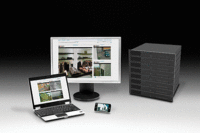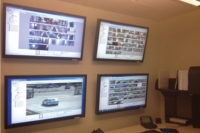
The first simple caveat to consider is, if it isn’t broken there’s no reason to fix it. Most existing analog CCTV systems perform their tasks in a satisfactory manner, and there may be no viable reason to add network connectivity or devices. That said, the older the existing components are, the more benefits can be achieved by networking.
When considering whether to add IP network technology to a client’s system, the simple question to answer is, how will the client benefit from the updated system? From a system salesperson’s perspective, the technical advantages of networked surveillance video must be presented to the client as simplified benefits that will convince the client to upgrade his or her system.
Let’s look at a few possible ways to upgrade existing analog CCTV systems — examining the potential benefits for the end user and the different networking options that are available, and some important issues for installing companies to consider.

Security IP video encoder/decoder sets can be used to connect remote analog cameras to existing DVR inputs.
CONNECT REMOTE CAMERAS/LOCATIONS TO AN EXISTING SYSTEM
A key benefit of networking CCTV systems is the ability to utilize existing cabling and communications connectivity to greatly extend the distance(s) between cameras and head-end equipment.There are a number of technologies available that can be used to achieve the desired result. As illustrated, IP-enabled cameras can transmit the video images over the Internet or WAN (Wide Area Network) connection. Existing (or new) analog cameras can be connected to video encoders that perform the compression and network transmission functions.
At the receiving end, decoders can be used to convert the remotely-transmitted IP video signals back into an analog signal, which can then be fed into the existing DVR as a separate signal to be viewed and recorded. This arrangement leverages the existing recording and viewing equipment, providing a valuable upgrade for the client at a minimal cost.
Security companies contemplating such a system must be aware of a number of potential issues that can cause difficulties for this type of installation. First, the remote camera or encoder must be matched with the receiving decoder, and most likely must come from the same vendor. Manufacturers such as Bosch Security Systems provide mated IP cameras, encoders, and decoders; the Bosch VIP-XD decoder will receive both camera (Dinion NWC-0455) and encoder (VIP-X1) feeds, and can present them in a “quad” format, so up to four video feeds can be sent to one input channel of the existing DVR simultaneously. Another option for receiving the IP video signals is to upgrade the DVR to a hybrid NVR that can process both analog and IP signals.
The quality and available bandwidth of the proposed Internet or WAN connection must be tested to ascertain how many frames per second, at what compression settings, can be sent reliably over the remote connection. It’s very important for security dealers to understand that it may be difficult or impossible to transmit high-quality, 30-fps security video over a standard DSL, cable modem, or T-1 connection. Typical Internet connections will provide 3 to 5 fps of reasonable-quality video to a remote viewer/recorder; this fact should be explained and demonstrated to the client prior to the completion of the installation.
A client’s Internet connection is typically shared among their enterprise users, and used for business purposes. Putting a constant 24/7 stream of video onto a single shared Internet connection will cause a degradation of the enterprise users’ communications, and should be avoided. Either a separate Internet connection should be provided for the remote video feeds, or the IP cameras/encoders should be set to only transmit images when motion is detected or video analytics are triggered.

Any standard analog CCTV camera can be replaced with a hybrid IP/analog camera. The analog images stay on the local DVR and monitor while IP video streams can be remotely viewed and/or recorded. The output from any analog CCTV monitor can provide remote viewing over the Internet by using a Web server-based video encoder. Authorized viewers can access live security video images from any computer, anywhere, that’s connected to the Internet.
ADDING VIDEO ANALYTICS TO ANALOG SYSTEMS
With video analytics, clients can now use their CCTV systems to count people, vehicles, direction of motion, and many other actions viewed by their cameras. When properly presented, analytics can provide the sort of benefits that can make clients say “yes” to upgrading their existing system.The application of video analytics can be separated into two broad issues: first, the video images must be digitized, either at the camera/encoder or when processed by a DVR or NVR. Second, what device(s) will perform the actual analysis of the video streams?
There are currently two approaches for adding video analytics. By changing out the head-end DVR to an analytics system, all received video feeds can be run through the analysis software. This is a straightforward approach that will minimize or eliminate costs for new cameras, encoders, and the labor associated with such changes.
However, clients may not want to bear the cost of a complete video analytics system, and may only want specific camera outputs to be fed through the analysis process. This situation calls for the installation of IP cameras or encoders that have analytic capability built-in to the individual video device. Vendors such as Sony Electronics, Bosch Security Systems, and ioimage are including specific video analytic capabilities into their cameras and encoders, either as a basic feature or as a licensed software add-on.
So a specific camera, say, watching the front entrance of the client’s building, can be replaced with an analytics-ready IP camera, or the existing camera can be connected to an encoder that will perform the analytics function. An advantage to this approach is that analytics-ready cameras and encoders often include the option of triggering voltage or relay outputs when specific analytic events occur. These outputs can be connected into an annunciation panel, burglar alarm system, or access control panel to sound alarms, lock doors, or perform other functions when unacceptable activity is detected by the video camera. In that way, video analytics can provide an automated gateway between traditional physical security systems and CCTV devices.
Getting analytics to work properly can be quite tricky. Readers should review the article “Video Analytics: Working Smart for your Client,” posted atwww.sdmmag.com.
Analytics is a fabulous “seed” technology for security integrators. Properly installed and functioning video analytics in one or two cameras will open a client’s eyes to the power of IP video, and will cause them to want more of their cameras modernized with analytics.

NETWORK UPGRADES — USING HYBRID CAMERAS
While IP cameras and encoders provide many advantages over analog devices, it may be difficult to convince a client who has recently invested a substantial amount of money into a traditional CCTV system that a system-wide upgrade should be performed.“Hybrid” cameras, which provide both analog and network video outputs, provide a simple method to upgrade existing customers’ systems. Manufacturers such as Speco Technologies, JVC Professional Products, Panasonic Security Systems, Bosch Security Systems, and others produce hybrid cameras that can be used to replace standard analog cameras. Typically these hybrid cameras are in a standard form factor, and can use a variety of industry-standard lenses, housings, and mounting hardware.
A typical application for hybrid cameras is the situation where a client wants one or a few cameras to be available for remote viewing over the LAN or Internet. By replacing a standard analog camera with a hybrid, the video can be made available for authorized users over the network while the analog feed still provides video for the local monitor and DVR.
With this approach, cameras in critical areas — such as at the front entry to a building, loading dock, or computer room — can be upgraded with hybrid devices, while the remainder of the CCTV system stays as is.
Another advantage of using hybrid analog/IP cameras is the ability to send critical video signals off-site for redundant recording purposes. If there’s a natural disaster or a successful attack on the localized recording equipment, remotely recorded video still will be accessible for review.
A growing usage for hybrid devices is the use of cameras or video encoders that include video analytics software. Analytics can be added to a system relatively inexpensively, while the analog signal remains available for the local system. Many hybrid cameras are used in retail, where clients are using network video feeds for viewing and recording, while pushing a single analog video feed to an overhead monitor at a building entry to remind customers that the premises are protected with a CCTV system.

PUT THE MONITOR ON THE INTERNET
Every existing client who has a CCTV monitor and a broadband Internet connection can have security video made accessible over the Internet. In this scenario, authorized users can remotely view whatever is viewed on the local monitor over the Internet.One consideration when planning this type of installation is that the resolution and compression settings of the encoder may make the network-based viewing of a “quad” monitor less than perfect, as the encoder will take the complete image from the monitor, encode and compress it, and push it through the network.
This is a very powerful sales option for security dealers, as it requires only a single device installation — the encoder — and no changes to any other devices on the client’s system. The simplicity and low cost of this network video option make it a perfect fit for a wide range of clients, particularly small retail locations such as convenience stores and the like.

The output from any analog CCTV monitor can provide remote viewing over the Internet by using a Web server-based video encoder. Authorized viewers can access live security video images from any computer, anywhere, that’s connected to the Internet.
PROVIDE ONE-TO-MANY VIEWING CAPABILITIES
Any of the examples detailed above provide one of the most powerful features of networking video: one-to-many viewing.Most current IP CCTV products include two or more levels of users, with a “root” or “admin” user being able to change or modify the device’s settings, while “users” can only view the video feed. If setting up multiple users, it’s important that the root or admin level of user be reserved for those who need it, while other authorized viewers should be programmed for lower level status.
ONE TECHNOLOGY, MANY CUSTOMERS
IP-enabled video security devices can be quickly and widely implemented for any existing CCTV system client, adding valuable features and benefits that can only come from networked solutions. Security dealers need to sell the concrete benefits of video networking, understand the available options for implementation, know their selected product lines, and carefully check the client’s network and Internet connection(s) for functionality.
Sidebar: Common Issues and Problems
Regardless of the type of network video devices being considered, security integrators need to carefully survey the client’s existing network cabling, connectors, and equipment to assure that the planned devices will function properly.Up to 60 percent of network failures can be traced to a breakdown of cabling and/or connectors. If planning to use existing cabling and connectors, each cable should be fully tested for correct connections and adherence to industry standards for bandwidth capacity. Inexpensive testers are available that will verify that an RJ-45 socket is properly wired, and that Ethernet connectivity is present. It’s important that security integrators specify in their agreement that any existing cabling to be used must meet minimum industry performance standards, and that any cost for cabling repairs will be borne by the client.
If planning to use the Internet for remote video connections, it’s important to test the client’s ISP service for packet loss, latency, and bandwidth capabilities. Network video produces many thousands of data packets in a matter of seconds; placing a constant video stream onto an enterprise ISP connection will cause reduced bandwidth for other users, slowing their Internet use experience. This reality can cause client dissatisfaction with the security video installation. Security dealers should be prepared for this, and suggest to the client that a separate broadband ISP connection be provided specifically for security video use.
Some analog CCTV cameras do not produce an exact 1-volt peak-to-peak output, as some camera manufacturers will increase their product’s voltage output to compensate for cabling irregularities or to provide a more vibrant image on an analog monitor screen. Although these higher-voltage cameras will not generally cause problems for a purely analog CCTV system, some IP video encoders will not accept a video signal whose voltage output is too high (or too low). If planning to use existing analog cameras, the voltage outputs should be tested to verify that the particular camera’s output falls within the acceptable range of the video encoder planned for the installation.

